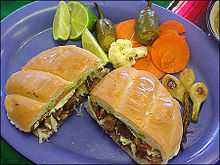Torta
| Torta | |
|---|---|
.jpg) Torta cenceña made in la Roda | |
| Recipes at Wikibooks: | |
|
| |
| Media at Wikimedia Commons: | |
|
|
Torta (Spanish pronunciation: [ˈtorta]) is a Spanish (but also an Italian and Portuguese and French, tartre) word with a wide array of culinary meanings. It originated in different regional variants of flatbread, of which the torta de gazpacho[1] and torta cenceña[2] are still surviving in certain areas of central Spain. Tortas are also mentioned in Leviticus 24:5-9, in the Spanish translation of the Bible. Presently, however, the word torta is also applied to different kinds of bread and pastry products according to the region.
Historically the difference between torta and bread was its round and flat shape, as well as the absence of yeast in its preparation. The well-known word tortilla, used mainly in Mexico (not in Spain, though), means a "small torta", while tortada means "big torta". In most regions a torta was traditionally considered an inferior form of bread, as the well known Spanish aphorism expresses:
|
|
In turn, in Mexico a variation says: A falta de pan, tortillas ("Where there is no bread, tortillas are fine")
In various countries of Latin America the word torta means different things. Nowadays a very common usage is for sweet cakes, such as a wedding or birthday cake. This meaning is also present in other European languages, for example, the Italian torta, German torte or French tarte.
Torta frita is a fried flatbread eaten in Uruguay and Argentina. Other uses of the word torta include Huevo en torta, a small fried mixture of scrambled eggs, not to be confused with Torta de huevo, a typical pastry from Sobrarbe, Aragon, Spain, and Torta del Casar, a cheese made from sheep's milk in Extremadura, Spain.
The Italian torta is differentiated from crostata by the filling: a crostata has an inconsistent chunky filling, whereas a torta has a consistent filling made of blended ingredients.[3]
Mexico

In Mexico a torta is a kind of sandwich,[4] served on an oblong 15 cm firm, crusty white sandwich roll, called a bolillo, telera, birote, or pan francés, depending on the region. Tortas can be eaten cold or hot, grilled or toasted in a press in the same manner as a cuban sandwich or panini.
Garnishes such as avocado, poblano, jalapeño, tomato, and onion are common. The dish is popular throughout Mexico, and is also available anywhere with a large number of Mexican immigrants. In Northern Mexico, the torta is very frequently called lonche by influence of the English "lunch", as it may be eaten during lunch break.
The sandwich is normally named according to its main ingredient:
- Torta de jamón, ham-filled torta
- Torta de aguacate, avocado-filled torta
- Torta de adobada, adobo meat-filled torta
- Torta de huevo, scrambled eggs-filled torta
- Torta de milanesa, milanesa meat-filled torta
But the torta ahogada, the "drowned" torta of Guadalajara is so called because it is smothered in a red sauce. Different fillings are available and they may be mixed to create an original torta.
Due to the practicality of being hand-carried, tortas are sold at massive events such as football matches, parades, and outdoor concerts, but they are also available for breakfast, lunch, or dinner at dedicated establishments or sold as street food by food carts.
In Mexico, the sweet cake, is normally referred to as pastel, which is also used in other parts of Latin America with this meaning.
Philippines

In the Philippines, particularly among Northern and Tagalog-speaking provinces and islands, torta refers to a kind of omelette made with eggs, ground meat and sometimes minced onion and potato.
In Visayas and Mindanao, torta refers to a native porous sponge cake delicacy that resembles a large cupcake with butter, sugar, and/or cheese on top traditionally served with "tsokolate" - a thick, hot drink made of ground roasted cacao seeds - for afternoon snack or merienda. Traditional recipes vary from family to family or from town to town, but the ingredients basically consist of flour, egg yolks, milk, fresh coconut sap as sweetener, lard as shortening, and a bit of salt. The mixture is poured into small tin trays lined with Japanese paper that are brushed with margarine or butter and then slow-baked in a stone oven heated with burning wood or coconut husks.[5] It differs from the 'torta mamon,' or 'mamon'[6] which is a mini sponge cake made of white egg yolks and baked sweet using refined white cane sugar or puto mamon.
Gallery
-

Torta de Chicharrones from Galicia, Spain
-

Old drawing of a woman selling tortas
-
Torta from Ribagorza, Aragon, Spain
-
Torta Imperial, Spain
-

Torta verde from Ventimiglia, Italy
-

Mexican torta ahogada, a pork sandwich with chili/tomato sauce, onion slices and lime juice
-

Tortas being prepared on a griddle in Oaxaca, Mexico
-

Mexican Torta de Huevo
See also
- Tortilla
- Migas
- Torta de Gazpacho
- Sopaipilla
- Arepa
- Pupusa
- List of sandwiches
References
- ↑ Albacete - Gazpachos Manchegos
- ↑ La Roda, torta cenceña
- ↑ Capatti, Alberto; Montanari, Massimo (2003, original Italian in 1999). "Italian cuisine". Arts and Traditions of the Table Series. Translated by Áine O'Healy (Columbia University Press). ISBN 0231122322. Page 60.
- ↑ "Mexican Torta recipe"
- ↑ "La Torta de Argao"
- ↑ "Mamon Filipino"
External links
- Torta de Pan Viejo
- Éxodo 29:2 y pan sin levadura, y tortas sin levadura (Spanish)
- Semicultured.com photos of torta sandwich





